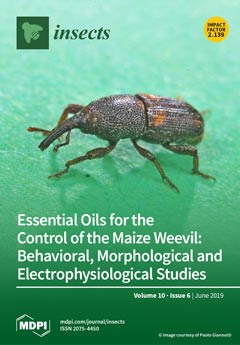Entomopathogenic fungi are commonly applied as inundative sprays to protect plants against insect pests. Their artificial establishment as fungal endophytes to provide other benefits to the host plants aside mere protection against the primary pests has also been widely demonstrated. In the present study, two fungal strains of
Beauveria bassiana and one strain of
Isaria fumosorosea were assessed in a pathogenicity test against adults of Asian citrus psyllid (
Diaphorina citri) and found to induce 50% reduction in the survival rate of
D. citri adults within 5 days of exposure. The ability of the three fungal strains to endophytically colonize
Citrus limon, the impact on plant growth and the effects of systemic colonization on 3 successive generations of
D. citri feeding on colonized plants was evaluated. Citrus seedlings at 4 months post-planting were inoculated with each of the fungal strains via foliar spraying. Both strains of
B. bassiana successfully colonized the seedlings. One of the
B. bassiana strains (BB Fafu-13) was sustained up to 12 weeks in the colonized seedlings, whereas the other
B. bassiana strain (BB Fafu-16) was only recovered up to 8 weeks post-inoculation.
Isaria fumosorosea (IF Fafu-1) failed to colonize the plant. Both strains of
B. bassiana induced significant improvement in plant height and flush production in endophytically colonized seedlings. In addition, endophytic
B. bassiana caused 10–15%
D. citri adult mortality within 7 days of exposure. Female
D. citri feeding on
B. bassiana challenged plants laid fewer eggs as compared to those feeding on endophyte-free seedlings, while reduction in adult emergence was recorded on
B. bassiana treated plants. With this study, we present the first evidence of
B. bassiana artificial establishment as fungal endophyte in citrus plants and its negative effects on
D. citri.
Full article






